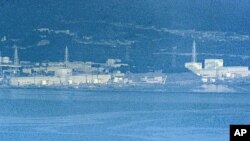The United Nations' top nuclear official says the situation at Japan's troubled nuclear power plant continues to be very serious as Japanese authorities struggle to bring the situation under control. The U.N.'s nuclear energy body - the International Atomic Energy Agency - says radiation levels in a village outside Japan's nuclear evacuation zone are twice the levels believed safe for habitation.
International Atomic Energy Agency Director General Yukiya Amano says Japanese authorities are facing a number of difficulties as they try to bring the situation at the Fukushima Daiichi nuclear power plant under control.
"My understanding is that the situation continues to be very serious and the effort to overcome this crisis is increasing. At the same time, they encounter difficulties, like the existence of water or high levels of radiation," he said.
For three weeks, Japan has struggled to bring the situation at the radiation-leaking plant under control. Setbacks mounted on Wednesday as sea water nearby the plant tested at its highest levels yet. Japan's nuclear safety agency says radioactive iodine was detected at more than 3,000 times allowable levels in the ocean about 300 meters from the plant.
|
VOA's Steve Norman spoke with Dr. Jane Orient, executive director of the Association of American Physicians and Surgeons, about the radiation leakage at Fukushima and whether the news media coverage helps to inform or does it unnecessarily frighten people. She says only people such as plant workers directly exposed to radiation leakage will likely have any significant contamination.
|
The IAEA also revealed Wednesday that radiation levels in Iitate, a village located about 40-kilometers northwest of the plant and outside the evacuation zone, were above those believed to be safe for habitation. The nuclear monitoring agency has told the Japanese government about its findings and said authorities in Japan are looking into the assessment.
The environmental activist group Greenpeace has urged Japanese authorities to expand the evacuation zone from 20 to 30 kilometers, as their independent radiation readings also showed higher than safe levels. Top government spokesman Yukio Edano said the government was prepared to study the organization's data.
Japan's government has imposed a 20-kilometer evacuation zone around the plant, and recommended that residents up to 30 kilometers away remain indoors.
IAEA Director General Amano, however adds that it was not all bad news. "There has been also some progress. I really hope the efforts by the emergency workers would lead to the stabilisation of the reactors and this accident and crisis situation," he said.
Leaking radiation from the Fukushima plant - the worst nuclear crisis since Chernobyl in 1986 - has not only raised concerns about whether areas around the site were safe for habitation but the safety of milk, produce and tap water as far away as Tokyo - which is more then 200 kilometers south of the plant.
Late Wednesday, a small but noisy group of protesters gathered in Tokyo outside the headquarters of the Tokyo Electric Power Company to voice their opposition to nuclear energy.
Thirty-four-year-old Chika Ito was among the protesters. "I had never really thought about it before but, because of the crisis, it has got me thinking of how frightening nuclear energy is," he said.
On Wednesday Japanese authorities announced a new set of safety measures for the country's 55 nuclear power plants. A panel of nuclear specialists has been organized to find ways to shut down the plant and prevent the further spread of radiation.













